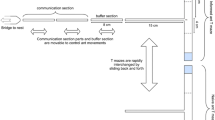Abstract
Many social insect species that employ directional recruitment to food finds communicate the location of their targets with seemingly needless imprecision. Here we present evidence that the spatial precision of the honey bees' dance communication has been “tuned” by selection so that recruits are neither so accurate that they usually find areas which have already been depleted nor so inaccurate that they usually fail to find the advertised resources altogether. First, the bees' distance errors are similar in magnitude to their directional errors, and their angular errors decrease greatly with increasing distance to the target (decreasing more than fourfold between 100 and 700 m). As a result, the absolute scatter of recruits remains relatively constant with changing distance to the target (increasing by less than 50% between 100 and 700 m). This is to be expected if the optimal level of imprecision is the same for distance and direction and does not change with the distance of the target from the nest. Second, comparative studies involving three tropical- and one temperate-zone species (all Apis)suggest that the precision of the bees' languages may have been tuned in accordance with the spatial characteristics of the resources each species uses. We suggest that both the round dance, which conveys no directional information for nearby targets, and the high angular divergence in waggle dances indicating targets within several hundred meters of the colony are both understandable in this context.
Similar content being viewed by others
References
Deneubourg, J. L., Pasteels, J. M., and Verhaeghe, J. C. (1983). Probabilistic behavior in ants: A strategy of errors?.Theor. Biol. 105: 259–271.
Edrich, W. (1975). The waggle dance of the honey bee; a new formulation.Fortschr. Zool. 23(1): 20–30.
Free, J. B., and Williams, I. H. (1983). Scent-marking of flowers by honeybees.J. Apicult. Res. 22(2): 86–90.
Gary, N. E., and Witherell, P. C. (1971). A method for training honey bees to forage at feeding stations.Ann. Entomol. Soc. Am. 64: 448–449.
Gould, J. L. (1975a). Honey bee recruitment: The dance-language controversy.Science 189: 685–693.
Gould, J. L. (1975b). Communication of distance information by honey bees.J. Comp. Physiol. 104: 161–173.
Gould, J. L. (1975c).Honey Bee Communication: The Dance-Language Controversy, Ph.D. thesis, The Rockefeller University, New York.
Gould, J. L. (1976). The dance-language controversy.Q. Rev. Biol. 51: 211–244.
Gould, J. L. (1980). The case for magnetic sensitivity in birds and bees (such as it is).Am. Sci. 68: 256–267.
Haldane, J. B. S., and Spurway, H. (1954). A statistical analysis of communication inApis mellifera and a comparison with communication in other animals.Insectes Sociaux 1: 247–283.
Heinrich, B. (1979).Bumblebee Economics, Harvard University Press, Cambridge, Mass., and London.
Hubbell, S. P., and Johnson, L. K. (1978). Comparative foraging behavior of six stingless bee species exploiting a standardized resource.Ecology 59: 1123–1136.
Lindauer, M. (1956). Öber die Verständigung bei indischen Bienen.Z. vergl. Physiol. 38: 521–557.
Lindauer, M. (1957). Communication among the honeybees and stingless bees of India.Bee World 38(1): 3–14, 34–39.
Martin, H. and Lindauer, M. (1977). Der Einfluss der Erdmagnetfelds und die Schwereorientierung der Honigbiene.J. Comp. Physiol. 122: 145–187.
Regal, P. J. (1982). Pollination by wind and animals: Ecology of geographic patterns.Annu. Rev. Ecol. Syst. 13: 497–524.
Seeley, T. D. (1985a). The information-center strategy of honeybee foraging.Fortschr. Zool. 31: 75–90.
Seeley, T. D. (1985b).Honeybee Ecology, Princeton University Press, Princeton, N.J.
Seeley, T. D. (1986). Social foraging by honeybees: How colonies allocate foragers among patches of flowers.Behav. Ecol. Sociobiol. 19: 343–354.
Towne, W. F. (1985).The Spatial Precision and Mechanisms of the Dance Communication of Honey Bees, Ph.D. dissertation, Princeton University, Princeton, N.J.
Towne, W. F., and Gould, J. L. (1985). Magnetic field sensitivity in honey bees. In Kirschvink, J. L., Jones, D. S., and McFadden, B. J. (eds.),Magnetite Biomineralization and Magnetoreception in Organisms, Plenum Press, New York, pp. 385–406.
Visscher, P. K., and Seeley, T. D. (1982). Foraging strategy of honeybee colonies in a temperate deciduous forest.Ecology 63: 1790–1801.
von Frisch, K. (1948). Gelöste und ungelöste Rätsel Bienensprache.Naturwissenschaften 35: 12–23, 38–43.
von Frisch, K. (1967).The Dance Language and Orientation of Bees, Harvard University Press, Cambridge, Mass.
von Frisch, K., and Lindauer, M. (1961). Öber die “Missweisung” bei den richtungsweisenden Tänzen der Bienen.Naturwissenschaften 48: 585–594.
Waddington, K. D. (1981). Patterns of size variation in bees and evolution of communication systems.Evolution 35: 813–814.
Whitehead, D. R. (1969). Wind pollination in the angiosperms: Evolutionary and environmental considerations.Evolution 23: 28–35.
Wilson, E. O. (1962). Chemical communication among workers of the fire antSolenopsis saevissima (Fr. Smith). 1. The organization of mass-foraging. 2. An information analysis of the odour trail. 3. The experimental induction of social responses.Anim. Behav. 10: 134–164.
Wilson, E. O. (1971).The Insect Societies, Harvard University Press, Cambridge, Mass.
Author information
Authors and Affiliations
Rights and permissions
About this article
Cite this article
Towne, W.F., Gould, J.L. The spatial precision of the honey bees' dance communication. J Insect Behav 1, 129–155 (1988). https://doi.org/10.1007/BF01052234
Accepted:
Issue Date:
DOI: https://doi.org/10.1007/BF01052234




